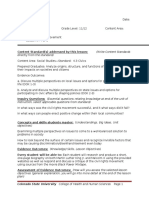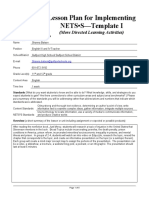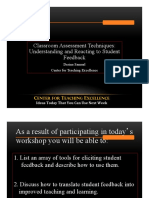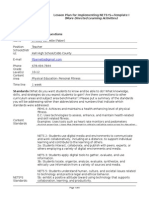CEP Lesson Plan Form: Colorado State University College of Health and Human Sciences Page 1
CEP Lesson Plan Form: Colorado State University College of Health and Human Sciences Page 1
Uploaded by
api-279610141Copyright:
Available Formats
CEP Lesson Plan Form: Colorado State University College of Health and Human Sciences Page 1
CEP Lesson Plan Form: Colorado State University College of Health and Human Sciences Page 1
Uploaded by
api-279610141Original Title
Copyright
Available Formats
Share this document
Did you find this document useful?
Is this content inappropriate?
Copyright:
Available Formats
CEP Lesson Plan Form: Colorado State University College of Health and Human Sciences Page 1
CEP Lesson Plan Form: Colorado State University College of Health and Human Sciences Page 1
Uploaded by
api-279610141Copyright:
Available Formats
CEP Lesson Plan Form
Teacher: Mitch McFall
Date: 03/11/15
School:
Town High
Teen Choices
Grade Level: High School Content Area:
Title: Drug Free Me! Lesson 3
Content Standard(s) addressed by this lesson:
directly from the standard)
FCCLA.02
Lesson #: 3 of 6
(Write Content Standards
Applied Technology
FCCLA. Student
48
Body
FMCS.0 (Teen) Analyze factors that influence human growth &
5
development.
FMCS.05. (Teen) Analyze conditions that influence human growth and
01
development.
FMCS.05.0 (Teen) Analyze the effects of life events on individuals' physical, intellectual,
1.a
social, moral, and emotional development.
RWC10-GR.9-S.4GLE.2-EO.a
Analyze the purpose, question at issue, information, points of
view, implications and consequences, inferences, assumptions
and concepts inherent in thinking
Understandings: (Big Ideas)
The different types of illicit substances, and their varying and similar effects on the
human body, and its growth and development.
Inquiry Questions: (Essential questions relating knowledge at end of the unit of
instruction, select applicable questions from standard)
What are the different classifications of illicit substances, and what does that name
entail?
What effects do each of these substances have on the human body, and which do
they all share in common?
Evidence Outcomes: (Learning Targets/Objectives)
Every student will be able to: create an adequate presentation, demonstrating
knowledge and research skills about our assigned illegal substances.
I can: research and present my topic substance, and show that I can
accurately demonstrate my acquired knowledge on the subject.
This means: that application of knowledge, and the ability to accurately
present it, is an important skill for a student to learn.
Colorado State University College of Health and Human Sciences
Page 1
CEP Lesson Plan Form
List of Assessments: (Write the number of the learning target associated with
each assessment)
Formal assessment, informal WDYL. The students will be making a presentation,
then presenting it the next week. Also, Ill ask a what did you learn question as a
ticket out the door.
List of Significant Vocabulary: (List the significant vocabulary words and
definitions for this lesson)
The vocab will be mostly individual based on
the groups topics, but effect, addictiveness, and the substance itself will all be
critical.
Colorado State University College of Health and Human Sciences
Page 2
CEP Lesson Plan Form
Planned Lesson Activities
Name and Purpose of Lesson
Should be a creative title for you and the students
to associate with the activity. Think of the purpose
as the mini-rationale for what you are trying to
accomplish through this lesson.
Approx. Time and Materials/Procedures
How long do you expect the activity to last and
what materials will you need? What do you need
to collect, prepare, reserve, set-up, etc. ahead of
time?
Drug Free Me! Lesson 3. The purpose of this lesson is to get
students informed on the effects of various types of drugs and
alcohol, as well as to get them to present the information to the
class.
Pre-Assessment
How will you pre-assess students knowledge of
the topic to be covered? Describe both formal
and informal ways you will assess their knowledge
Anticipatory
Set/Focus/Hook/Engagement/Motivation/Intr
oduction
The hook grabs students attention and
engages them from the start. These are actions
and statements by the teacher to relate the
experiences of the students to the objectives of
the lesson and to put students into a receptive
frame of mind.
To focus student attention on the lesson.
To create an organizing framework for the
ideas, principles, or information that is to
follow (advanced organizers)
An anticipatory set is used any time a different
activity or new concept is to be introduced.
Procedures/Instructional Input/Learning
Chunks/Scaffolding for Learning (this is the
largest part of your lesson plan)
There will be no real pre-assessment for this lesson, but a quick
discussion can be implemented if need be.
This will take the majority of the class time, and the students
will vote on which format of presentation they will want to use.
If they choose a power point, we will use a computer lab or the
library, and if they choose poster, we will stay in the classroom,
and use poster material (paper, drawing utensils, poster paper,
etc.)
The students should be shown examples of the assignment, and
questions can be asked by the teacher to get them excited to
do the project. They can also choose which substance they are
assigned, just to get them interested.
The main body of class will be in the chosen area of work, and
throughout the lesson you will walk around and ask questions,
look over their progress, and help to make changes throughout.
Colorado State University College of Health and Human Sciences
Page 3
CEP Lesson Plan Form
(Include a play-by-play account of what will
happen in the class from the minute students
arrive to the minute they leave your classroom.
Indicate the length of each segment of the lesson.
List actual minutes.)
Include the following components in scripted
format:
-Teacher input-what you will share (lecture
outline, notes of interest, facts, vocabulary,
description of activities, etc.)
-Modeling (demonstrations, stories, examples,
etc.)
-questioning strategies (what questions will you
ask to CSU)
-guided/unguided:
-whole-class practice
-group practice
-individual practice
-check for understanding
-other (FCCLA, FFA, etc. connection)
Closure/Conclusion/Summary/Adjustments/
Wrap-up/Clean-up
Those actions or statements by a teacher that are
designed to bring a lesson presentation to an
appropriate conclusion. Used to help students
bring things together in their own minds, to make
sense out of what has just been taught. Any
Questions? No. OK, lets move on is not closure.
Closure is used:
To cue students to the fact that they have
arrived at an important point in the lesson
or the end of a lesson.
To help organize student learning
To help form a coherent picture and to
consolidate.
Differentiation/Modifications/Adaptations/Ac
If students have questions, or the class needs guidance, of
course, take care of it.
This material will mostly be learned throughout the assignment,
but the students will have learned chunks of it from previous
units in the class.
They will also learn more during the next lesson, where they
will see a power point about effects, which they can use to add
more to their project, or not.
Closure will involve a WDYL, and of course a time to clean up
the work space. They can also use this time to exchange
personal information, that way if for whatever reason they want
to work on the project outside of class, they can.
Students who need to be grouped differently should take to the
Colorado State University College of Health and Human Sciences
Page 4
CEP Lesson Plan Form
commodations To modify: If the activity is too
advanced for a child, how will you modify it so
that they can be successful?
To extend: If the activity is too easy for a child,
how will you extend it to develop their emerging
skills?
Assessment/Pre-Post/On-going
How will you know if students met the learning
targets? Review each learning target and
determine the assessment that met that target.
Can the students answer your inquiry questions?
Write a description of what you were looking for in
each assessment.
teacher, and adjustments will be made.
Also, if a group is having any conflict, that should be dealt with
accordingly.
The main idea behind assessment for this project, is to gain an
understanding of the students abilities to identify an object,
describe the attributes, and give the implications of using it.
This will help them to make better choices later in life.
Colorado State University College of Health and Human Sciences
Page 5
CEP Lesson Plan Form
Post Lesson Reflection
1. To what extent were lesson objectives achieved? (Utilize
assessment data to justify your level of achievement)
2. What changes, omissions, or additions to the lesson would
you make if you were to teach again?
3. What do you envision for the next lesson? (Continued practice,
reteach content, etc.)
Colorado State University College of Health and Human Sciences
Page 6
You might also like
- Second Grade Science LessonDocument15 pagesSecond Grade Science Lessonlionheart10131333% (3)
- Inquiry 5e Lesson PlanDocument2 pagesInquiry 5e Lesson Planapi-433012475No ratings yet
- 5e Science Lesson PlanDocument10 pages5e Science Lesson Planapi-300269240No ratings yet
- Developmental Review Oluwaseun PopoolaDocument6 pagesDevelopmental Review Oluwaseun PopoolaOluwaseun PopoolaNo ratings yet
- Task Rotation Lesson PlanDocument3 pagesTask Rotation Lesson Planapi-231354055100% (2)
- MM - B412, B432, B512, MB472, MB492, MB562, ES4132, ES4192, ES5112, ES5162 (Option Tray) - 1Document18 pagesMM - B412, B432, B512, MB472, MB492, MB562, ES4132, ES4192, ES5112, ES5162 (Option Tray) - 1Vitalij KrivenNo ratings yet
- CEP Lesson Plan Form: Colorado State University College of Health and Human Sciences Page 1Document6 pagesCEP Lesson Plan Form: Colorado State University College of Health and Human Sciences Page 1api-279610141No ratings yet
- Lesson 1 of 6Document6 pagesLesson 1 of 6api-279610141No ratings yet
- CEP Lesson Plan Form: Colorado State University College of Health and Human Sciences Page 1Document6 pagesCEP Lesson Plan Form: Colorado State University College of Health and Human Sciences Page 1api-279610141No ratings yet
- CEP Lesson Plan Form: Colorado State University College of Health and Human Sciences Page 1Document6 pagesCEP Lesson Plan Form: Colorado State University College of Health and Human Sciences Page 1api-279610141No ratings yet
- CEP Lesson Plan Form: Colorado State University College of Health and Human Sciences Page 1Document5 pagesCEP Lesson Plan Form: Colorado State University College of Health and Human Sciences Page 1api-279610141No ratings yet
- CEP Lesson Plan Form: Colorado State University College of Health and Human Sciences Page 1Document5 pagesCEP Lesson Plan Form: Colorado State University College of Health and Human Sciences Page 1api-279610141No ratings yet
- STEPP Lesson Plan Form: Content Standard(s) Addressed by This LessonDocument5 pagesSTEPP Lesson Plan Form: Content Standard(s) Addressed by This Lessonapi-335950861No ratings yet
- Lesson Plan - 1Document5 pagesLesson Plan - 1api-286837832No ratings yet
- Sitting in A Garden LessonDocument8 pagesSitting in A Garden Lessonapi-514518399No ratings yet
- Discuss and Plan How You CanDocument12 pagesDiscuss and Plan How You CanKina YahyaNo ratings yet
- Stepp Lesson Plan 2oDocument6 pagesStepp Lesson Plan 2oapi-284284138No ratings yet
- Scopes Monkey Trial Lesson PlanDocument7 pagesScopes Monkey Trial Lesson Planapi-310504510No ratings yet
- Post Civil Rights Movement Lesson PlanDocument6 pagesPost Civil Rights Movement Lesson Planapi-273727066No ratings yet
- Lesson Plan For Implementing NETS - S-Template I: (More Directed Learning Activities)Document5 pagesLesson Plan For Implementing NETS - S-Template I: (More Directed Learning Activities)api-665745963No ratings yet
- Unit Design in The Standards-Based Classroom: 1. On Which Content Standard(s) Will The Students Be Working?Document10 pagesUnit Design in The Standards-Based Classroom: 1. On Which Content Standard(s) Will The Students Be Working?api-245307519No ratings yet
- Strategies For Effective Lesson Planning: Stiliana Milkova Center For Research On Learning and TeachingDocument8 pagesStrategies For Effective Lesson Planning: Stiliana Milkova Center For Research On Learning and TeachingDánisaGarderesNo ratings yet
- Sorting Lesson PlanDocument4 pagesSorting Lesson Planapi-267077176No ratings yet
- How To Make A Lesson PlanDocument4 pagesHow To Make A Lesson PlanIsabel Jimenez100% (1)
- Planner Made Easy1Document4 pagesPlanner Made Easy1api-16307116100% (1)
- Lesson PlanDocument6 pagesLesson Plansch.gela.filesNo ratings yet
- Understanding Inequalities Lesson Plan 2Document3 pagesUnderstanding Inequalities Lesson Plan 2api-292180035No ratings yet
- Lesson-Plan-Template-Inquiry-Math Sci Ss Integrated-LitDocument4 pagesLesson-Plan-Template-Inquiry-Math Sci Ss Integrated-Litapi-240343298No ratings yet
- Key Assessment 3 Lesson Plan Analysis Rubric p69-76Document8 pagesKey Assessment 3 Lesson Plan Analysis Rubric p69-76api-215636357No ratings yet
- Lesson Plan Template: Essential QuestionDocument4 pagesLesson Plan Template: Essential Questionapi-531359203No ratings yet
- Banking Saving Investing 3lpDocument6 pagesBanking Saving Investing 3lpapi-282027876No ratings yet
- EDUC 2220-Educational Technology Lesson Plan Template: Name of Your LessonDocument4 pagesEDUC 2220-Educational Technology Lesson Plan Template: Name of Your Lessonkayebaye_08No ratings yet
- Columbus Lesson PlanDocument8 pagesColumbus Lesson Planapi-310437278No ratings yet
- Lesson Plan For Implementing NETS - S-Template I: (More Directed Learning Activities)Document5 pagesLesson Plan For Implementing NETS - S-Template I: (More Directed Learning Activities)api-510297964No ratings yet
- Edpr4100 Sciencesandslesson4sitesearchpart2Document4 pagesEdpr4100 Sciencesandslesson4sitesearchpart2api-252533855No ratings yet
- 3 Steps For Preparing A Lesson PlanDocument5 pages3 Steps For Preparing A Lesson PlanVicco Piodos100% (1)
- College of Education Lesson Plan GuidebookDocument13 pagesCollege of Education Lesson Plan Guidebookapi-242142698No ratings yet
- Stepp Review Activity 1Document6 pagesStepp Review Activity 1api-281839323No ratings yet
- CT Observation 2 Lesson PlanDocument6 pagesCT Observation 2 Lesson Planapi-376909408No ratings yet
- Generalization Lesson Plan Edu505Document10 pagesGeneralization Lesson Plan Edu505api-284836900No ratings yet
- Inquiry Based Lesson Plan Body Systems LabDocument3 pagesInquiry Based Lesson Plan Body Systems Labapi-436861773No ratings yet
- CTE Workshop On Classroom Assessment TechniquesDocument26 pagesCTE Workshop On Classroom Assessment TechniquesSwami Gurunand100% (1)
- Lesson Template (edTPA Aligned)Document3 pagesLesson Template (edTPA Aligned)bbrossardNo ratings yet
- Diversity LessonDocument5 pagesDiversity Lessonapi-254206113No ratings yet
- Science Observation JanDocument7 pagesScience Observation Janapi-242367514No ratings yet
- Banking Saving Investing 1lpDocument11 pagesBanking Saving Investing 1lpapi-282027876No ratings yet
- Lesson Plan For Implementing NETS - S-Template I: (More Directed Learning Activities)Document4 pagesLesson Plan For Implementing NETS - S-Template I: (More Directed Learning Activities)api-319316297No ratings yet
- Chapter Ix Lesson PlanDocument6 pagesChapter Ix Lesson PlanLa RaNo ratings yet
- Ste Teacher Work Sample Website - Chance TorrenceDocument31 pagesSte Teacher Work Sample Website - Chance Torrenceapi-376266093No ratings yet
- Analysis: The Basicprocess: The AddiemodelDocument15 pagesAnalysis: The Basicprocess: The AddiemodelShofiah Nur AzizahNo ratings yet
- Statistics Lesson PlanDocument3 pagesStatistics Lesson Planapi-240153916No ratings yet
- Inquiry (5E) Lesson Plan Template: Teachers: Subject: GradeDocument3 pagesInquiry (5E) Lesson Plan Template: Teachers: Subject: Gradeapi-488039794No ratings yet
- Instructional Strategy Genetics LPDocument6 pagesInstructional Strategy Genetics LPapi-283801432No ratings yet
- Argumentation and Debate LessonDocument6 pagesArgumentation and Debate Lessonapi-283604512No ratings yet
- Detailed Full Lesson PlanDocument6 pagesDetailed Full Lesson Planapi-234333471No ratings yet
- Educ450 lp1 Extrema Plan ExpandedDocument5 pagesEduc450 lp1 Extrema Plan Expandedapi-295344110No ratings yet
- Banking Saving Investing 5lpDocument19 pagesBanking Saving Investing 5lpapi-282027876No ratings yet
- So2 Pre-Observation ReflectionDocument2 pagesSo2 Pre-Observation Reflectionapi-309758533No ratings yet
- (More Directed Learning Activities) : Lesson Plan For Implementing NETS - S-Template IDocument6 pages(More Directed Learning Activities) : Lesson Plan For Implementing NETS - S-Template Iapi-284583527No ratings yet
- Blueprint For Thoughtful Lesson Planning: Excavating For Conceptual UnderstandingFrom EverandBlueprint For Thoughtful Lesson Planning: Excavating For Conceptual UnderstandingNo ratings yet
- Goals Decisions Worksheet: Mitch Mcfall Tws Section 6 Assessment Data and AnalysisDocument2 pagesGoals Decisions Worksheet: Mitch Mcfall Tws Section 6 Assessment Data and Analysisapi-279610141No ratings yet
- CEP Lesson Plan Form: Colorado State University College of Health and Human Sciences Page 1Document5 pagesCEP Lesson Plan Form: Colorado State University College of Health and Human Sciences Page 1api-279610141No ratings yet
- Tws 3 StandardsDocument2 pagesTws 3 Standardsapi-279610141No ratings yet
- Illicit Substance EffectsDocument12 pagesIllicit Substance Effectsapi-279610141No ratings yet
- Weekly Assignments CalendarDocument2 pagesWeekly Assignments Calendarapi-279610141No ratings yet
- Drug Free BillboardDocument1 pageDrug Free Billboardapi-279610141No ratings yet
- Health and Diets Webquest Activity Sheet Name: By: Mitch Mcfall DateDocument1 pageHealth and Diets Webquest Activity Sheet Name: By: Mitch Mcfall Dateapi-279610141No ratings yet
- BD 31 01Document52 pagesBD 31 01Oriku Abiodun100% (1)
- HOMERPublicationsDocument4 pagesHOMERPublicationsAsep WidodoNo ratings yet
- Ezra Pound ABC of Reading PDFDocument2 pagesEzra Pound ABC of Reading PDFLisaNo ratings yet
- 240 55864490Document10 pages240 55864490REZANo ratings yet
- AMREF - AWiM19 Sponsorship ProposalDocument29 pagesAMREF - AWiM19 Sponsorship ProposalPower to Youth KenyaNo ratings yet
- Price List For GRE Piping MaterialDocument1 pagePrice List For GRE Piping MaterialRamadan RashadNo ratings yet
- What Are The Main Differences Between The Orientation Design School and Planning School Guidance On Formalizing The StrategyDocument3 pagesWhat Are The Main Differences Between The Orientation Design School and Planning School Guidance On Formalizing The StrategykarimaelNo ratings yet
- Examiner's Interview: F1 - Accountant in Business: Business. The Examiner, Bob Souster, Has Provided The Answers and HisDocument12 pagesExaminer's Interview: F1 - Accountant in Business: Business. The Examiner, Bob Souster, Has Provided The Answers and HisKhurram AzizNo ratings yet
- M Tech - Energy-Technology Course STR and SyllabusDocument1 pageM Tech - Energy-Technology Course STR and SyllabusAnkur MaheshwariNo ratings yet
- Coursera LBKZQJAVS6B3 DiabetesDocument1 pageCoursera LBKZQJAVS6B3 DiabetesLuis EscudeiroNo ratings yet
- Sensor On OverlockDocument32 pagesSensor On OverlocksandipkadoliNo ratings yet
- Chrome TailingsDocument5 pagesChrome Tailingsnickie2611No ratings yet
- PRIST RESEARCH-Profile - May2014 PDFDocument4 pagesPRIST RESEARCH-Profile - May2014 PDFravi196No ratings yet
- More Exercises Exercise 1: Supply The Correct Word FormDocument3 pagesMore Exercises Exercise 1: Supply The Correct Word FormBích TrâmNo ratings yet
- Security Alarm Using Ardiuno and SensorDocument20 pagesSecurity Alarm Using Ardiuno and SensorShashank KundenaNo ratings yet
- Questions On UtilitarianismDocument2 pagesQuestions On Utilitarianismstudnt07No ratings yet
- Data Sheet Hvac System For Aradh Control Building ER-3148 Hawiyah Gas Development PipelinesDocument7 pagesData Sheet Hvac System For Aradh Control Building ER-3148 Hawiyah Gas Development Pipelinesari78No ratings yet
- Private School ThesisDocument5 pagesPrivate School Thesishod1beh0dik3100% (1)
- Reflection & EmpathyDocument20 pagesReflection & Empathyd.s100% (1)
- This Study Resource Was: ST ND RD TH THDocument5 pagesThis Study Resource Was: ST ND RD TH THDesmond WilliamsNo ratings yet
- Development of Attendance System Using Biometric Fingerprint IdentificationDocument4 pagesDevelopment of Attendance System Using Biometric Fingerprint IdentificationRonald RiveraNo ratings yet
- Marketing Tool: Event Management Is The Application ofDocument4 pagesMarketing Tool: Event Management Is The Application ofZak SullyNo ratings yet
- Experiment No: 4: TITLE: 4-Bit Comparator AIM: To Design 4-Bit Comparator Using IC 7485 Prior ConceptDocument43 pagesExperiment No: 4: TITLE: 4-Bit Comparator AIM: To Design 4-Bit Comparator Using IC 7485 Prior ConceptKelvin CooperNo ratings yet
- 2023 Hit-List For Public AdministrationDocument7 pages2023 Hit-List For Public AdministrationmanalkimannuNo ratings yet
- Gizmo Energy ConversionsDocument6 pagesGizmo Energy ConversionsDerick GeorgesNo ratings yet
- RPH EXCEL CEFR Bahasa Inggeris Form 1-5Document17 pagesRPH EXCEL CEFR Bahasa Inggeris Form 1-5NOORZATUL IFFAH BINTI BADRUL KHAIRI MoeNo ratings yet
- Online CCAs PDFDocument3 pagesOnline CCAs PDFHaider Ali SwatiNo ratings yet
- W80 Triplex Pump W375 Quintuplex PumpDocument2 pagesW80 Triplex Pump W375 Quintuplex Pumpadewunmi olufemiNo ratings yet
- Pelf Infotech PVT LTD: Sbi Colony, Opp - Swapna Shilp, Kothrud, Pune - 411 038Document5 pagesPelf Infotech PVT LTD: Sbi Colony, Opp - Swapna Shilp, Kothrud, Pune - 411 038Abhijeet PatilNo ratings yet































































































